You are probably familiar with the saying “carrying the weight of the world on his shoulders.” This situation was attributed to show off the strength of the ancient Greek God, Atlas. Today this phrase has evolved to mean someone who takes on more problems than he or she could or should. Either way, it conjures up images of a very uncomfortable condition, one which no one would want to endure.
Along with neck pain, shoulder pain has become increasingly common and more and more painful. Many of the causes of shoulder pain come from improper movements made in the shoulder area, medical conditions such as arthritis, overuse, and stressful situations.
Listed below are the top 10 most common reasons people suffer from shoulder pain and what can be done to alleviate these pains.
[h3line h3-text=”1. Frozen Shoulder“]
[su_row][su_column size=”1/2”]
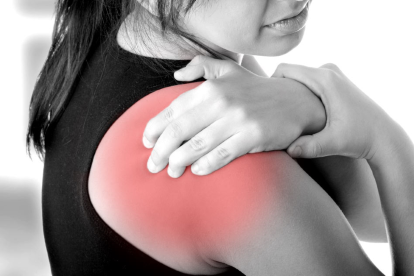
[/su_column][su_column size=”1/2″]
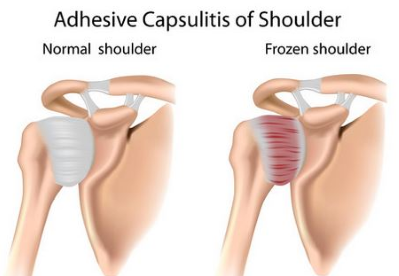
[/su_column][/su_row]
What is it?
Medically known as adhesive capsulitis, a frozen shoulder is a very common but unfortunately very painful condition that greatly cuts down on the range of motion you have using your shoulders. It starts off slowly and can go on for a year or more.
How do you get it?
Frozen shoulder is more common in women than men and anyone can end up with one once they begin to change the way they move their shoulder. It can be from an injury or surgery but once you begin to compromise your movements the condition begins and gets worse until treatment has begun.
Treatments:
Surgery is an option but there are many effective ways to treat frozen shoulder right from your own home and with a little assistance from your physician. For pain, you may want to use over-the-counter nonsteroidal anti-inflammatory drugs, also known as NSAIDS (Advil, Aleve). Treating the area with heat and implementing stretching exercises can get the healing process moving. If you need extra assistance, ask your doctor if he can give you a steroid shot to cut down on the pain. Be patient; it could take 6 months to a year but you should see relief.
[h3line h3-text=”2. Torn Rotator Cuff“]
[su_row][su_column size=”1/2”]

[/su_column][su_column size=”1/2″]
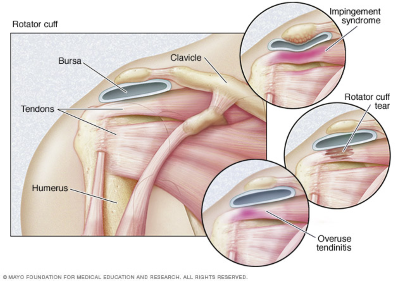
[/su_column][/su_row]
What is it?
A torn rotator cuff is another condition that reduces the range of motion in the shoulder area. It may be difficult to carry on simple everyday tasks. Patients may find their arm becoming weak so they may cut down on their regular movements. This could turn your torn rotator cuff into a frozen shoulder.
How do you get it?
This condition is usually the result of an injury but it can also come about from the regular wear and tear on the shoulder that comes with overuse and age. Repetitive movements can also be the culprit. Many athletes and those involved in jobs in the construction industry are often targeted with a torn rotator cuff after repeating the same actions over and over again.
Treatments:
The sooner you have been examined and diagnosed as having a torn rotator cuff the better chance you have of a positive and quicker recovery. There are surgical procedures that must be used to correct the damage caused by the tear in the rotator cuff. Get to a doctor right away if the pain in your shoulder lasts longer than a couple of weeks.
[h3line h3-text=”3. Osteoarthritis“]
[su_row][su_column size=”1/2”]
[/su_column][su_column size=”1/2″]
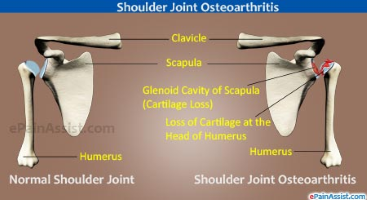
[/su_column][/su_row]
What is it?
While many people identify arthritis as a disease for older people, the truth is that osteoarthritis is a condition that can show up in the shoulder (or other joints) as a result of regular wear and tear that occurs over time. When it happens in the shoulder it most likely can be found in the acromioclavicular, or AC, joint. The AC joint is where you will find the shoulder blade joining forces with the collarbone.
How do you get it?
Many people who suffer from this form of arthritis are older than 50 years of age. You can also develop osteoarthritis as the result of an injury or dislocating your shoulder.
Treatments:
Once again, because pain is the major symptom of osteoarthritis of the shoulder, a proper diagnosis is important. Your physician will use x-rays, and MRI and specific blood tests to narrow down his or her prognosis. An examination of the fluid that lubricates the joints can also confirm that it is osteoarthritis.
[h3line h3-text=”4. Rheumatoid Arthritis“]
[su_row][su_column size=”1/2”]

[/su_column][su_column size=”1/2″]
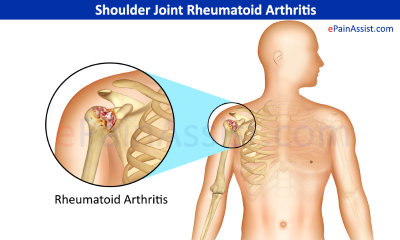
[/su_column][/su_row]
What is it?
Rheumatoid arthritis, or RA, is the other form of this degenerative disease. One of the main differences between the two forms of arthritis is that RA is where the body begins to attack healthy joints. You can find RA in one shoulder but more than likely it will show up in both shoulders. As it works its damage on the tissues of the shoulder it can continue leaving bones of the shoulder rubbing against each other. RA is a very painful condition and when it affects the shoulders it can seriously create a limited range of motion.
How do you get it?
Because RA is more of a condition, it is an autoimmune illness that can affect people of any age. Unlike osteoarthritis that is the result of wear and tear, RA is where the body starts attacking its own joints and tissues. You can have RA as a result of your family history or you might end up with it because of an infection. Doctors are still unsure as to how the disease actually occurs so it is wise to get a diagnosis at the first sign of problems. X-rays and MRIs can confirm the existence of RA in the shoulder.
Treatments:
Prescription and over-the-counter medications can help with the pain of RA in the shoulder. Nonsteroidal anti-inflammatory products can bring swelling down and stronger prescribed drugs, such as Rheumatrex, Actrema, and Trexall can specifically work to decrease the impact of the RA. Physical therapy and stretching exercises can help to increase the range of motion. If all else fails, there is a surgical procedure that may be able to help but your best bet is to exhaust all other options before going under the knife.
[h3line h3-text=”5. Dislocated Shoulder“]
[su_row][su_column size=”1/2”]

[/su_column][su_column size=”1/2″]
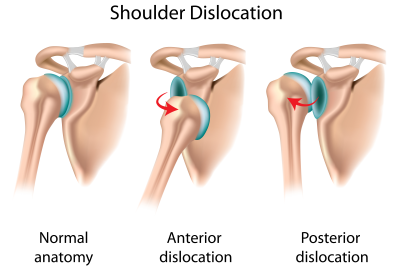
[/su_column][/su_row]
What is it?
Because of their level of mobility, shoulders are easy targets for many problems, dislocation being one of them. A dislocated shoulder occurs when the bone in your upper arm moves out of the socket in your shoulder blade. This bone is usually nestled comfortably in a cup-shaped part of the blade so when it is displaced it is very uncomfortable. There are two different ways it becomes dislocated: if the humerus ends up on the front of the shoulder blade it is considered to be an anterior dislocation and if it is behind the shoulder blade it is a posterior dislocation. Anterior dislocations are much more common, 95 percent as opposed to 5 percent for posterior dislocations.
How do you get it?
The most common way to dislocate your shoulder is through a sports injury, fall, or a sudden trauma. It could be the result of an indirect or direct trauma but it is the unexpected jarring that causes the shoulder to pop out of the socket. You may actually be able to see that the shoulder is visibly dislocated. It will be very painful so you won’t have to wait to be told to seek medical attention.
Treatments:
If you can see that the shoulder is clearly out of the socket do not try to push it back into place. Put ice on the affected area and keep the shoulder in a stable position. An x-ray or MRI will be able to show the dislocation in a clear image. Treatments include surgery, prescription medications, a sling or stint to keep the shoulder in place and/or rehab to build up your strength and expand your range of motion.
[h3line h3-text=”6. Separated Shoulder“]
[su_row][su_column size=”1/2”]

[/su_column][su_column size=”1/2″]
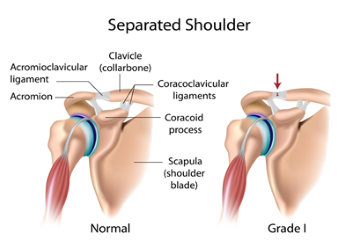
[/su_column][/su_row]
What is it?
A dislocated shoulder and a separated shoulder may sound like the same thing but they are not. A separated shoulder occurs when the collarbone moves out of place due to a torn ligament. When it is out of its usual position the collarbone pushes up towards the upper portion of the shoulder creating a distorted appearance.
How do you get it?
The circumstances that can result in a separated shoulder include falling down on a very hard surface, using your hands to break your fall, and suffering a blow to your shoulder. If someone were to twist your shoulder it could become separated and there are a number of sports that could separate the shoulder including football, soccer, hockey, skiing, rugby, volleyball, and rock climbing. If you are involved in any of these activities and you experience extreme pain in your shoulder you may have separated it. It may also become bruised, swollen and appear distorted.
Treatments:
If you believe that your shoulder is separated, make sure you apply ice to the affected area for around 30 minutes every four hours for up to three days or more. Over-the- counter anti-inflammatory drugs, such as ibuprofen (Aleve, Advil, Motrin) can reduce the swelling and ease your pain. A sling to keep your shoulder in place can also cut down on your discomfort and unless you need surgery to correct your separated shoulder, check with your doctor to see which exercises can help to build your strength and stretch out the shoulder muscles.
[h3line h3-text=”7. Ruptured Tendons of the Biceps“]
[su_row][su_column size=”1/2”]
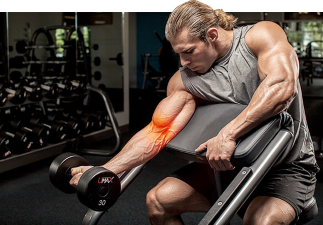
[/su_column][su_column size=”1/2″]
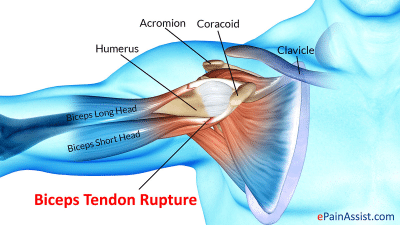
[/su_column][/su_row]
What is it?
Experiencing a ruptured tendon of the bicep is not a common problem to have. The tissue that holds the muscle and the bone together is called a tendon. An extreme force that is applied to the tendon can cause it to rupture and even snap. If you feel or hear a pop in your biceps you may have ruptured a tendon. With a rupture you could feel a great deal of pain and feel extreme weakness in your arm.
How do you get it?
While there are specific actions that can rupture a tendon of the biceps, there are some conditions that can increase your chances. If someone injects steroids to treat tendonitis they may end up with a ruptured tendon in the biceps. Having blood type O is another factor that can result in this condition as well as specific illnesses such as hyperparathyroidism and gout. Getting older puts you at a greater risk of ending up with a ruptured tendon of the biceps. Putting too much stress on your muscles through excessive weight training of 150 pounds and up is another reason people end up with a ruptured biceps tendon.
Treatments:
If you feel that you may have a ruptured tendon of the biceps you should check with your physician for a definite diagnosis. There is a surgical procedure that is available but many surgeons don’t suggest it to their patients. There are things you can do at home to help heal this situation. Make sure that you rest the area that is experiencing the pain. Apply ice on a regular basis and wrap the area that is affected. Make sure that it is wrapped well with an ACE bandage but do not make it too tight. If possible, elevate the arm so that it is resting comfortably above the heart.
[h3line h3-text=”8. Bursitis“]
[su_row][su_column size=”1/2”]
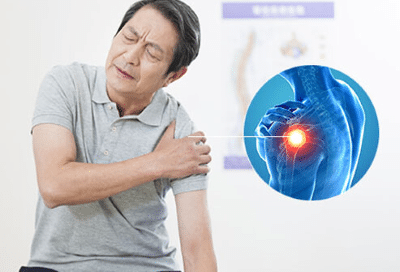
[/su_column][su_column size=”1/2″]
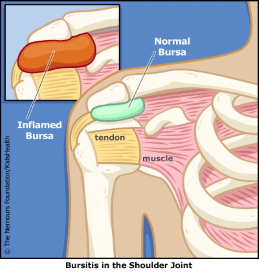
[/su_column][/su_row]
What is it?
The shoulder has a pouch that holds fluids so it can keep the areas around the muscles, tendons, bone, and skin from becoming irritated. Without the proper amount of lubrication in these areas a certain amount of friction will occur resulting in a condition called bursitis.
How do you get it?
There are a number of circumstances that can result in bursitis of the shoulder.
- A sudden injury to the area
- Repetitive movements that involve the shoulder
- Specific activities that are completed to the point of overuse that involve the shoulder, such as swimming, gardening, tennis, skiing, pitching and carpentry work
- Not stretching correctly before you exercise
- Certain medical conditions such as psoriatic arthritis, gout, rheumatoid arthritis, and disorders of the thyroid gland
If you experience pain and/or limited motion after meeting any of the above conditions that could result in bursitis you should check with a medical professional for a proper diagnosis.
Treatments:
Home remedies can be incorporated to relieve the pain of bursitis. Make sure to cease the activities that you believe may have caused your bursitis. Rest your shoulder and apply ice at the first sign of pain. Anti-inflammatory medications, such as Advil, Aleve, and Motrin, will help control the discomfort. If you find that the over-the-counter meds don’t do the trick your doctor may be able to prescribe something stronger called steroids. Besides a prescription a steroid injection may do a better job of eliminating the pain and any inflammation that you may have. There is a surgical procedure as a last resort but physical therapy should be considered before going under the knife.
[h3line h3-text=”9. Overexertion“]

What is it?
Everyone does it at one time or another – you just want to get that project completed; just one more game of tennis for the win; you can lift another 10 pounds if you put your mind to it. It’s called overexertion. You push yourself just a little too far and instead of achieving more you will probably find yourself laid up for weeks, maybe even months.
How do you get it?
Anytime you don’t work your way up slowly when you take on a physically difficult situation you could end up suffering from overexertion. It can happen at work, during sporting events, even at home while trying to perform deep spring cleaning chores. If someone ever challenges you to something you really don’t feel you are equipped to take on just say no or you could end up suffering for it in the long run.
Treatments:
Overexertion can easily be treated at home but it could take a couple of weeks to get back to your old self. Over-the-counter non-steroidal anti-inflammatory drugs (NSAIDS) can help to ease pain and reduce any swelling you may have. Take your pick – Advil, Motrin, Aleve – and take the one that works for you on a regular basis until your pain is completely gone. Rotate between applications of the heating pad and ice packs. And rest your shoulder so it has a chance to recuperate. You may also want to check out the effective handheld massagers that are available that can quickly bring you some soothing relief.
[h3line h3-text=”10. Pinched Nerves“]What is it?
A pinched nerve is actually a nerve that has become compressed. When this happens it in the shoulder area becomes extremely painful. It can be a short term or long term problem and if it isn’t treated it could even become a permanent problem. If you suffer from weakness in your shoulder, a tingling or numb feeling, or a very painful shoulder you may have a pinched nerve.
How do you get it?
You could cause a nerve in your shoulder to become compressed by sleeping with your arm bent throughout the whole night. If you keep performing the same motions over and over you may find that you are damaging your nerve endings and they are becoming pinched in the process. There are tests that your physician can administer that will be able to determine if you definitely have a pinched nerve.
Treatments:
The first thing you should do if you suspect a pinched nerve in your shoulders is to rest the area. You can ask your doctor for prescription medications for the pain and inflammation as well as a steroid shot for more instant but temporary relief. If you exhaust all other home remedies including physical therapy and wearing a splint, you may have to investigate any surgical procedures that are available.
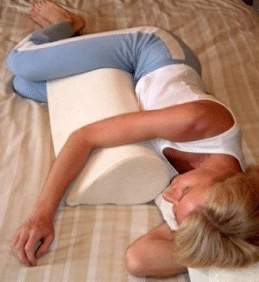
You probably don’t realize how much you use your shoulders until you are in pain and your range of motion has become diminished. Try to pace yourself and take it easy when performing physical tasks. It only takes a minute to find yourself out of commission for weeks or even months at a time. Make sure to check out the helpful products that are available to help relieve all phases of neck and shoulder pain you may be experiencing.

Hi there
Can someone help me please I have got pain in my arm between elbow and shoulder the pain is just below my shoulder had a ultrasound scan done GP is saying it’s nothing to worry about but
I am in server pain and the pain is more server in the night to much to bear I cry with the pain at night.
Hot water bottle or my husband rubs my arm or cushions or whatever nothing seems to work.
The pain is to hard to bear I am at breaking point.
It has been three months now sleepless nights my husband wakes up too disturbed sleep.
I wake up in the night with the thumping pain in my arm which is getting worse
I’m on ibuprofen tab and ointment called FENBID gel not working
Please can you suggest something that will help thanx